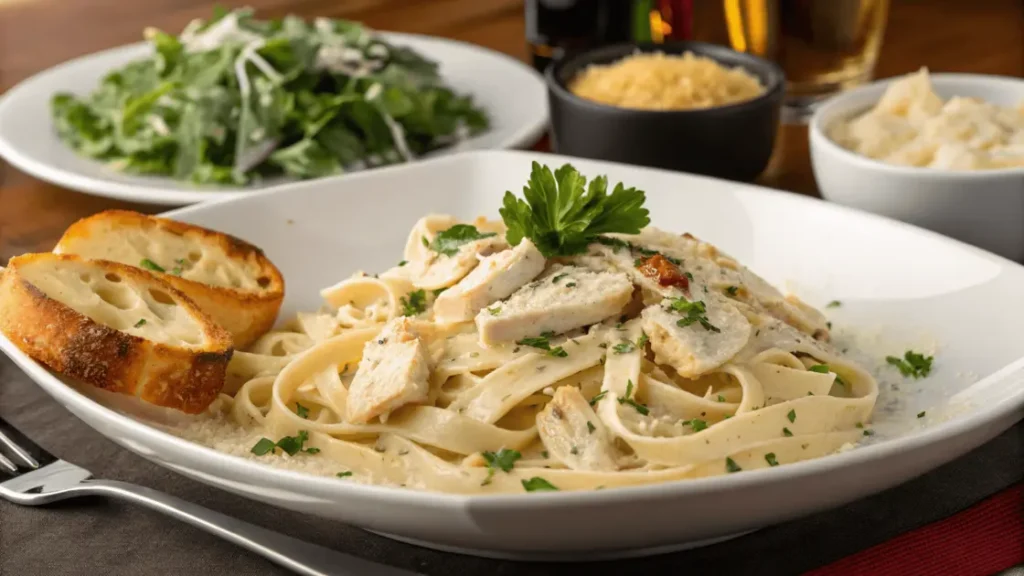Table of Contents
Chicken Fettuccine Alfredo is one of the most beloved pasta dishes worldwide. With its creamy, rich Alfredo sauce, tender chicken, and perfectly cooked fettuccine, it’s the ultimate comfort food. Whether you’re making it for a weeknight dinner or a special occasion, this dish is always a crowd-pleaser.
But did you know that the original Alfredo sauce didn’t even include cream? Let’s dive into its history before we get into the recipe.
History of Fettuccine Alfredo
Fettuccine Alfredo dates back to early 20th-century Italy. Alfredo di Lelio, an Italian chef, created the dish for his pregnant wife, who had lost her appetite. His simple recipe of butter and Parmesan cheese became a hit and eventually made its way to the United States, where heavy cream was added to make it even richer.
Today, Chicken Fettuccine Alfredo is a staple in Italian-American cuisine, loved for its creamy texture and indulgent flavor.
Ingredients Needed

For the Chicken
- 2 boneless, skinless chicken breasts
- 1 teaspoon salt
- ½ teaspoon black pepper
- ½ teaspoon garlic powder
- 2 tablespoons olive oil
For the Alfredo Sauce
- 4 tablespoons unsalted butter
- 2 cups heavy cream
- 1 cup freshly grated Parmesan cheese
- 3 garlic cloves, minced
- ½ teaspoon salt
- ¼ teaspoon black pepper
- ¼ teaspoon nutmeg (optional)
For the Pasta
- 12 oz fettuccine pasta
- 1 teaspoon salt (for boiling water)
Step-by-Step Cooking Instructions

Preparing the Chicken
- Dry and Pound for Even Cooking:
Start with boneless, skinless chicken breasts. Before seasoning, pat them dry with paper towels. For an even cook, consider gently pounding the thicker parts of the breast until you have a uniform thickness. This not only speeds up the cooking process but also helps achieve a nice, even sear. - Seasoning:
Generously season both sides with salt, freshly ground black pepper, and garlic powder. You can also add Italian seasoning or a pinch of paprika if you like a little extra flavor. Make sure the seasoning is well distributed over the surface. - Searing:
Heat a skillet over medium-high heat and add a drizzle of olive oil. When the oil shimmers, carefully place the chicken breasts into the pan without overcrowding. Allow them to cook undisturbed for about 5–6 minutes on the first side. This uninterrupted cooking creates a golden-brown, flavorful crust. - Flipping and Finishing:
Once a nice crust has formed and the chicken releases easily from the pan, flip it over. Continue cooking the other side for another 5–6 minutes until the internal temperature reaches 165°F (74°C). Using an instant-read thermometer can help ensure accuracy. After cooking, remove the chicken from the pan and let it rest for about 5 minutes. Resting allows the juices to redistribute throughout the meat, ensuring it stays moist when sliced.
Tip: Resting is key! Cutting into the chicken too soon can let the juices escape, leaving the meat drier.
Cooking the Fettuccine
- Boiling Water:
Fill a large pot with water and add a generous amount of salt. The water should taste as salty as the sea, which helps flavor the pasta from the inside as it cooks. - Cooking:
Bring the water to a rolling boil, then add the fettuccine. Stir occasionally to prevent the noodles from sticking together. Cook the pasta until it reaches an al dente texture—that is, tender yet still firm to the bite. This usually takes about 8–10 minutes, but check the package instructions for guidance. - Reserving Pasta Water:
Before draining, reserve about ½ cup of the pasta water. This starchy liquid can be invaluable later for adjusting the consistency of your sauce, ensuring it clings perfectly to every strand of pasta. - Draining:
Drain the fettuccine in a colander and set it aside. If not using immediately, toss with a tiny bit of olive oil to prevent sticking.
Tip: Al dente pasta works best with creamy sauces, as it continues to cook slightly when tossed with the warm sauce.
Making the Alfredo Sauce
- Starting with the Pan:
Using the same skillet you cooked the chicken in (this helps deglaze and pick up any flavorful bits left behind), lower the heat to medium. Add butter to the pan and let it melt completely. - Sautéing Garlic:
Once the butter is melted, add finely minced garlic. Sauté for about 30 seconds—just long enough for the garlic to become fragrant without browning or burning, which can introduce bitterness. - Adding the Cream:
Pour in the heavy cream slowly while stirring continuously. The cream should blend with the butter and garlic to form a smooth base. Keep the heat moderate to avoid a full boil; you want a gentle simmer that allows the cream to warm and thicken gradually. - Incorporating Cheese:
Gradually add freshly grated Parmesan cheese, stirring constantly. It’s best to add the cheese in small amounts so that it melts evenly into the cream. Continue stirring until the sauce becomes smooth and luxuriously creamy. - Seasoning the Sauce:
Taste and adjust with a pinch of salt, a bit of freshly ground black pepper, and a dash of nutmeg. The nutmeg adds a subtle warmth and depth to the sauce, making it more complex in flavor.
Tip: Avoid letting the sauce boil vigorously, as high heat can cause the cream to separate. Low and slow is the key to a silky-smooth Alfredo.
Combining Everything
- Mixing the Pasta:
Add the drained, warm fettuccine directly into the skillet with your Alfredo sauce. Using tongs or a pasta fork, gently toss the noodles so that every strand is evenly coated with the sauce. - Adding the Chicken:
Slice the rested chicken into strips or bite-sized pieces. Then, add these slices to the pasta and gently toss once more, ensuring the chicken is well distributed throughout the dish. - Adjusting Consistency:
If the sauce appears too thick, gradually stir in some of the reserved pasta water. This not only loosens the sauce but also enhances its ability to cling to the pasta due to the starch in the water. - Final Touches:
Once everything is combined and heated through, remove the pan from the heat. Garnish the dish with extra grated Parmesan cheese and a sprinkle of fresh parsley. Serve immediately while hot.
Tip: Serving immediately is important as Alfredo sauce tends to thicken further upon standing. Enjoy your dish while it’s warm and creamy!
Tips and Tricks for the Best Chicken Fettuccine Alfredo
Use Fresh Parmesan for the Best Texture and Flavor:
Freshly grated Parmesan melts into the sauce more evenly than its pre-shredded counterpart. This ensures a smoother, creamier consistency and a richer, more pronounced cheesy flavor. Fresh Parmesan also has a naturally complex taste that can elevate the entire dish, whereas pre-grated versions often include anti-caking agents that hinder its meltability.
Let the Chicken Rest Before Slicing to Keep It Juicy:
Once your chicken is cooked, resist the urge to slice it immediately. Allowing it to rest for about 5 minutes lets the internal juices redistribute throughout the meat. This step is crucial because cutting the chicken too soon can cause the juices to run out, leaving the meat dry and less flavorful.
Add Pasta Water to Loosen the Sauce if It’s Too Thick:
The reserved pasta water is a secret weapon in many Italian dishes. Because it’s starchy, it helps bind the sauce to the noodles while simultaneously thinning it out if the consistency becomes too heavy. Start by adding just a few tablespoons and stir to combine; you can always add a little more until you achieve your desired sauce consistency.
Common Mistakes to Avoid
Don’t Overcook the Chicken:
Overcooked chicken loses its natural moisture, making it tough and dry. Use a meat thermometer to ensure the chicken reaches just 165°F (74°C) and then allow it to rest. This precision in cooking prevents the chicken from becoming rubbery and ensures each bite remains tender.
Avoid Pre-Shredded Parmesan:
Pre-shredded cheese is convenient but it often contains additives that prevent it from melting smoothly. When making Alfredo sauce, these additives can lead to a grainy texture and less cohesive sauce. Grate your Parmesan fresh from a block for the best melt and flavor.
Don’t Let the Sauce Boil, or It May Separate:
Alfredo sauce relies on the delicate balance of cream, butter, and cheese. Boiling the sauce can cause the fats to break apart, leading to a separated, oily sauce instead of a velvety, cohesive one. Keep the heat at a gentle simmer and stir constantly to maintain that perfect emulsion.
Serving Suggestions

- Garlic Bread:
A warm, crusty garlic bread is perfect for soaking up every drop of the luscious Alfredo sauce. - Caesar Salad:
The crispness and tang of a Caesar salad offer a refreshing contrast to the rich, creamy pasta, balancing the meal beautifully. - Roasted Vegetables:
Vegetables like broccoli, asparagus, or Brussels sprouts add color and texture, and their natural sweetness complements the savory Alfredo. - A Glass of White Wine (Chardonnay):
A chilled glass of Chardonnay, with its buttery and slightly oaky notes, pairs wonderfully with the creaminess of the dish, enhancing the overall dining experience.
Variations of Chicken Fettuccine Alfredo
- Veggie Version:
For a lighter or vegetarian twist, consider adding mushrooms, spinach, or broccoli. These vegetables not only boost the nutritional value but also introduce new textures and flavors that work harmoniously with the Alfredo sauce. - Spicy Twist:
If you enjoy a bit of heat, sprinkle in some Cajun seasoning or red pepper flakes. This adds a spicy kick to the dish, creating an exciting contrast to the rich, creamy sauce. - Healthier Alternative:
To lighten up the dish without sacrificing too much creaminess, substitute half-and-half for heavy cream. While the sauce might be slightly less rich, it’s a great option for those looking for a lower-calorie version of this classic recipe.
How to Store and Reheat Leftovers
- Storing:
Place any leftovers in an airtight container. When properly stored, Chicken Fettuccine Alfredo will stay fresh in the refrigerator for up to 3 days. This keeps the flavors intact and prevents the sauce from absorbing other odors. - Reheating:
When it’s time to enjoy your leftovers, reheat the dish slowly on low heat. Adding a splash of milk while reheating helps restore the sauce’s creaminess, ensuring it doesn’t become too thick or dry. Stir frequently and add a little extra pasta water if needed to achieve the right consistency.
Conclusion
Chicken Fettuccine Alfredo is a timeless dish that’s both indulgent and versatile. With these tips and tricks, you can ensure that every component—from the tender, juicy chicken to the silky, perfectly balanced sauce—comes out just right. Whether you stick to the classic recipe or experiment with a variation, you’ll always have a delicious, comforting meal ready to impress family and friends.
FAQs
1. Can I use milk instead of heavy cream?
Yes, but it won’t be as rich. Try adding butter and flour to thicken it.
2. What can I substitute for Parmesan cheese?
Pecorino Romano or Grana Padano work well.
3. How do I make Alfredo sauce thicker?
Simmer it longer or add more Parmesan cheese.
4. Is there a dairy-free option for Alfredo sauce?
Yes! Use coconut milk or cashew cream instead of dairy.
5. Can I make Chicken Fettuccine Alfredo ahead of time?
Yes, but it’s best fresh. Store sauce separately for best results.


1 thought on “Chicken Fettuccine Alfredo”
Comments are closed.